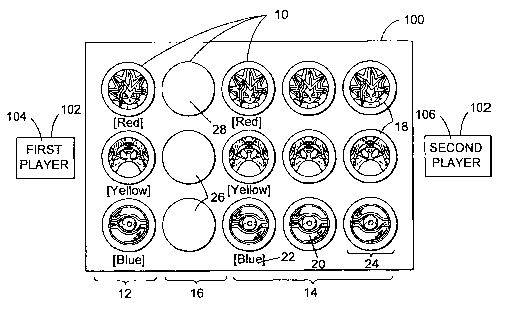Some of the information on this Web page has been provided by external sources. The Government of Canada is not responsible for the accuracy, reliability or currency of the information supplied by external sources. Users wishing to rely upon this information should consult directly with the source of the information. Content provided by external sources is not subject to official languages, privacy and accessibility requirements.
Any discrepancies in the text and image of the Claims and Abstract are due to differing posting times. Text of the Claims and Abstract are posted:
| (12) Patent Application: | (11) CA 2465504 |
|---|---|
| (54) English Title: | GUESS LOCATION GAME |
| (54) French Title: | JEU DE POSITIONS A DEVINER |
| Status: | Deemed Abandoned and Beyond the Period of Reinstatement - Pending Response to Notice of Disregarded Communication |
| (51) International Patent Classification (IPC): |
|
|---|---|
| (72) Inventors : |
|
| (73) Owners : |
|
| (71) Applicants : |
|
| (74) Agent: | NORTON ROSE FULBRIGHT CANADA LLP/S.E.N.C.R.L., S.R.L. |
| (74) Associate agent: | |
| (45) Issued: | |
| (86) PCT Filing Date: | 2002-10-31 |
| (87) Open to Public Inspection: | 2003-05-15 |
| Examination requested: | 2004-04-30 |
| Availability of licence: | N/A |
| Dedicated to the Public: | N/A |
| (25) Language of filing: | English |
| Patent Cooperation Treaty (PCT): | Yes |
|---|---|
| (86) PCT Filing Number: | PCT/US2002/035104 |
| (87) International Publication Number: | WO 2003039691 |
| (85) National Entry: | 2004-04-30 |
| (30) Application Priority Data: | |||||||||
|---|---|---|---|---|---|---|---|---|---|
|
A game including game pieces (10) and rules for playing a game for a plurality
of players (102), the goal of which is to score the most points by correctly
guessing the location of hidden items. The invention provides multiple
coverable items (12), multiple sets of markers (14), and multiple shells (16).
Multiple coverable items (12) may be hidden under multiple shells (16) in a
manner such that multiple sets of markers (14) may be used to guess the
location of the corresponding coverable items (12) by stacking a marker (14)
onto the corresponding shell (16).
L'invention concerne un jeu comprenant des pions (10) et des règles de jeu s'adressant à une pluralité de joueurs (102), le but du jeu étant d'enregistrer le plus grand nombre de points en devinant la position correcte d'éléments cachés. L'invention comporte plusieurs éléments (12) pouvant être recouverts, plusieurs ensembles de repères (14) et plusieurs coquilles (16). Plusieurs éléments (12) peuvent être recouverts par plusieurs coquilles (16), de sorte que plusieurs ensembles de repères (14) peuvent être nécessaires pour deviner la position des éléments (12) correspondants par placement d'un repère (14) sur la coquille (16) voulue.
Note: Claims are shown in the official language in which they were submitted.
Note: Descriptions are shown in the official language in which they were submitted.

2024-08-01:As part of the Next Generation Patents (NGP) transition, the Canadian Patents Database (CPD) now contains a more detailed Event History, which replicates the Event Log of our new back-office solution.
Please note that "Inactive:" events refers to events no longer in use in our new back-office solution.
For a clearer understanding of the status of the application/patent presented on this page, the site Disclaimer , as well as the definitions for Patent , Event History , Maintenance Fee and Payment History should be consulted.
| Description | Date |
|---|---|
| Application Not Reinstated by Deadline | 2007-10-31 |
| Time Limit for Reversal Expired | 2007-10-31 |
| Inactive: Office letter | 2007-09-07 |
| Appointment of Agent Requirements Determined Compliant | 2007-09-06 |
| Inactive: Office letter | 2007-09-06 |
| Revocation of Agent Requirements Determined Compliant | 2007-09-06 |
| Appointment of Agent Request | 2007-07-20 |
| Revocation of Agent Request | 2007-07-20 |
| Deemed Abandoned - Failure to Respond to Maintenance Fee Notice | 2006-10-31 |
| Inactive: IPC from MCD | 2006-03-12 |
| Inactive: IPC from MCD | 2006-03-12 |
| Inactive: Correspondence - Formalities | 2005-10-04 |
| Letter Sent | 2004-10-28 |
| Inactive: Single transfer | 2004-09-24 |
| Inactive: Acknowledgment of national entry - RFE | 2004-07-07 |
| Inactive: Cover page published | 2004-06-27 |
| Inactive: Acknowledgment of national entry - RFE | 2004-06-22 |
| Inactive: Courtesy letter - Evidence | 2004-06-22 |
| Letter Sent | 2004-06-22 |
| Application Received - PCT | 2004-05-31 |
| National Entry Requirements Determined Compliant | 2004-04-30 |
| Request for Examination Requirements Determined Compliant | 2004-04-30 |
| All Requirements for Examination Determined Compliant | 2004-04-30 |
| Application Published (Open to Public Inspection) | 2003-05-15 |
| Abandonment Date | Reason | Reinstatement Date |
|---|---|---|
| 2006-10-31 |
The last payment was received on 2005-10-04
Note : If the full payment has not been received on or before the date indicated, a further fee may be required which may be one of the following
Please refer to the CIPO Patent Fees web page to see all current fee amounts.
| Fee Type | Anniversary Year | Due Date | Paid Date |
|---|---|---|---|
| Request for examination - standard | 2004-04-30 | ||
| MF (application, 2nd anniv.) - standard | 02 | 2004-11-01 | 2004-04-30 |
| Basic national fee - standard | 2004-04-30 | ||
| Registration of a document | 2004-09-24 | ||
| MF (application, 3rd anniv.) - standard | 03 | 2005-10-31 | 2005-10-04 |
Note: Records showing the ownership history in alphabetical order.
| Current Owners on Record |
|---|
| MATTEL, INC. |
| Past Owners on Record |
|---|
| BRIAN YU |
| JONATHAN BEDFORD |